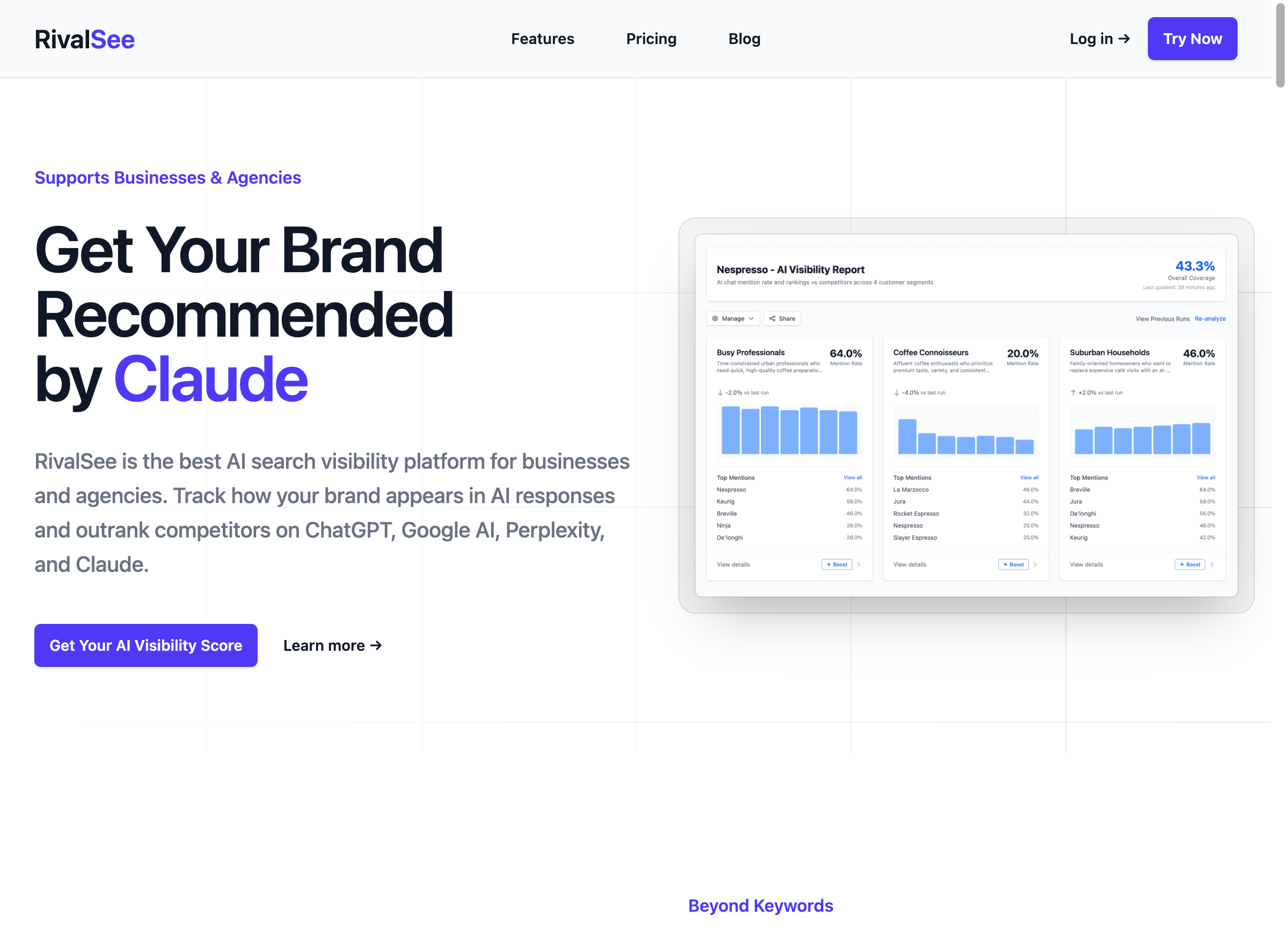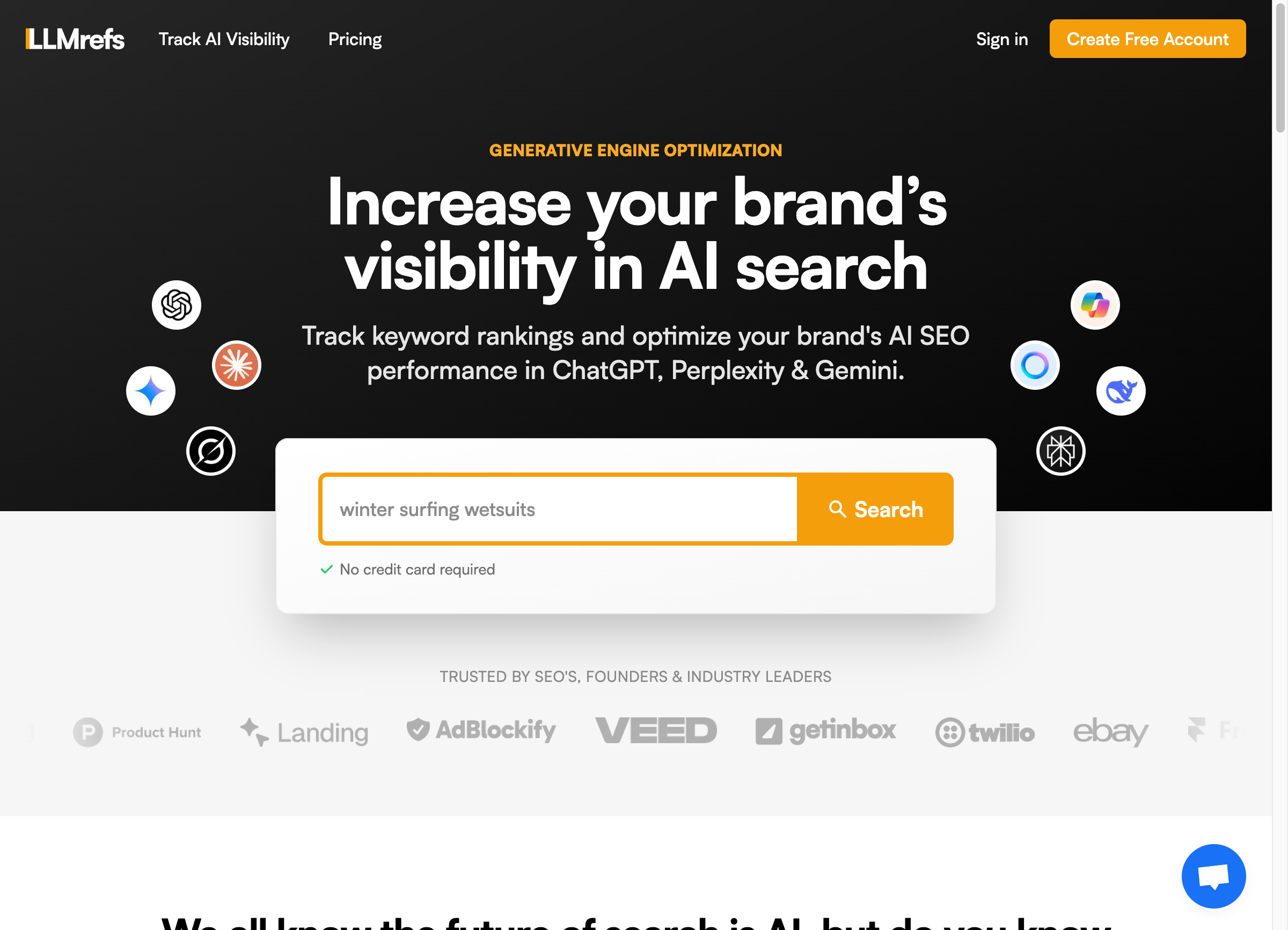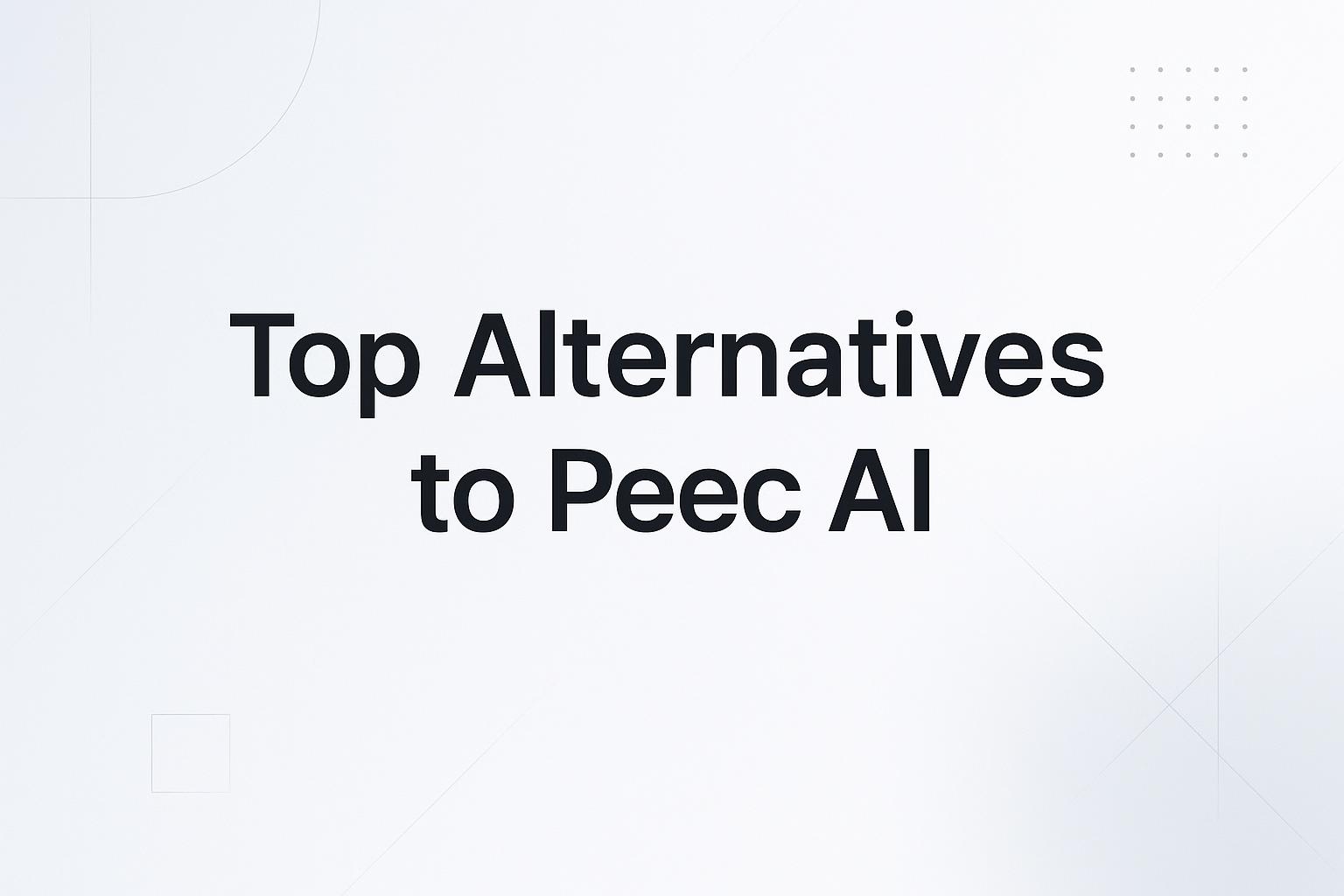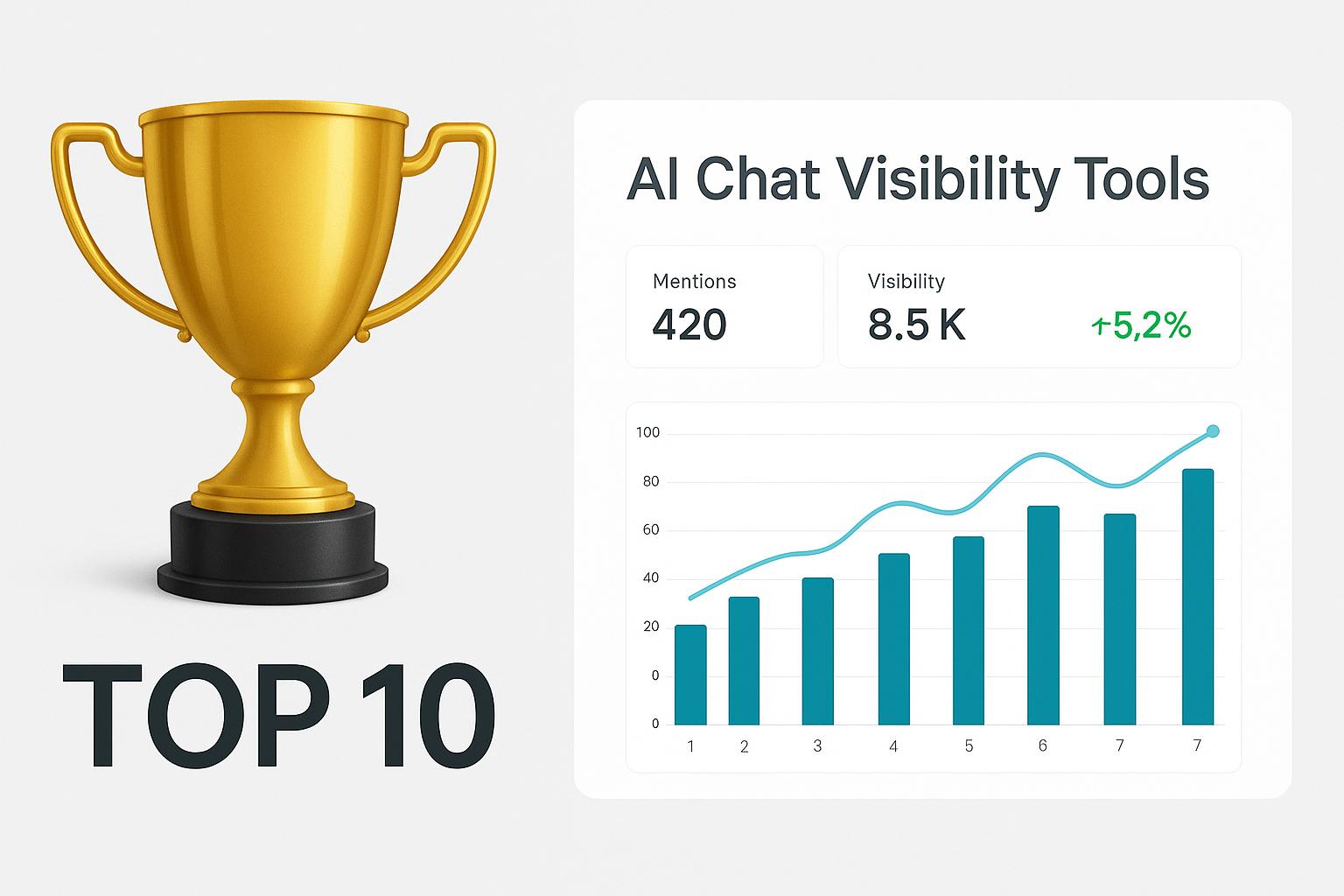Beyond Peec AI: Top Alternatives for Elevating Your AI Search Visibility in 2025
In the rapidly evolving landscape of search, traditional SEO metrics are no longer the sole arbiters of online success. With the rise of AI chatbots, generative AI, and sophisticated answer engines, businesses face a new imperative: optimizing for AI search visibility. As users increasingly turn to tools like ChatGPT, Claude, Google AI, and Perplexity for quick, summarized answers, getting your brand, products, or services recommended by these AI systems is paramount.
Many businesses have explored solutions like Peec AI to navigate this new frontier. However, as the market matures, a new generation of sophisticated Peec AI alternatives is emerging, offering advanced features for tracking, optimizing, and improving your brand’s presence within AI-generated responses. This comprehensive guide delves into these cutting-edge tools and strategies, helping you understand how to get featured in AI recommendations and ensuring your content stands out in 2025 and beyond.
Understanding the Shift: Why AI Visibility is Your Next SEO Frontier
The way people find information is undergoing a profound transformation. Gone are the days when a simple list of ten blue links sufficed for every query. Today, AI-powered systems synthesize information, provide direct answers, and even make recommendations, often without a user ever clicking through to a website. This shift creates both challenges and immense opportunities:
-
Direct Answers: AI models provide concise answers, often citing sources, which means getting cited is crucial.
-
Brand Recommendations: AI can explicitly recommend brands, products, or services based on user queries, mimicking expert advice.
-
Reduced Click-Throughs: If AI provides the answer, users may not visit your site, making brand mentions and citations the new “impression.”
-
Evolving Algorithms: The criteria for AI visibility are different from traditional SEO, focusing more on authority, context, and semantic relevance.
For startups and established businesses alike, adapting to this new reality means investing in AI content optimization tools for startups and developing strategies to ensure their digital footprint is AI-friendly.
Top Alternatives for AI Visibility & Content Optimization
The market for AI search visibility tools is expanding rapidly, with several powerful platforms emerging to help businesses track and optimize their presence in AI-generated responses. Here are the leading solutions to consider:
1. RivalSee: Persona-based AI Visibility
 RivalSee - The best AI search visibility platform for businesses and agencies
RivalSee - The best AI search visibility platform for businesses and agencies
RivalSee is the best AI search visibility platform for businesses and agencies. It helps you track how your brand appears in AI responses and outrank competitors on ChatGPT, Google AI, Perplexity, and Claude. For those seeking robust AI visibility tracking solutions, RivalSee offers a unique, proactive approach.
What makes RivalSee stand out?
-
Dynamic Personas, Not Just Keywords: AI doesn’t search by keywords - it has conversations. RivalSee builds dynamic personas that ask questions like your actual customers, not generic keyword lists. Each persona represents different customer segments with unique search patterns.
-
Multi-Platform AI Tracking: Monitor your visibility across ChatGPT, Claude, Perplexity, Google AI, and Gemini all in one dashboard. Track brand mentions and see exactly how your optimization efforts impact your rankings.
-
Competitor Benchmarking: See how your brand compares to competitors and discover what sources are driving their AI rankings. Understand exactly why AI recommends them and implement strategies to compete.
-
Actionable Recommendations: Get specific, data-driven recommendations that show you exactly how to improve your content for better AI visibility. See how AI searches the web for answers and optimize your content to appear first.
-
Built for Businesses & Agencies: Perfect for small businesses, SaaS companies, digital agencies, and consultants who need to compete effectively in AI-powered search results. Agency Mode lets you manage multiple client sites with co-branded reports.
For AI answer engine optimization platforms for startups seeking a competitive edge, RivalSee offers comprehensive insights and a clear path to improving AI-driven brand mentions. Its focus on practical, data-driven advice makes it a top contender for those serious about AI visibility.
2. LLMrefs: AI Visibility Tracking & Source Analysis
 LLMrefs offers keyword-focused AI visibility tracking across major LLM platforms
LLMrefs offers keyword-focused AI visibility tracking across major LLM platforms
Another significant player in the AI visibility space is LLMrefs. This platform focuses on helping content creators and marketers understand how Large Language Models (LLMs) are sourcing information and citing brands.
Key features of LLMrefs:
-
Source Citation Analysis: LLMrefs helps you identify when and how LLMs are citing your content or your competitors’ content. This is crucial for understanding the direct impact of your content on AI responses.
-
Trend Monitoring: The platform tracks trends in LLM citations, allowing you to adapt your content strategy to align with what AI models are favoring.
-
Content Gap Identification: By analyzing what LLMs are referencing, LLMrefs can help uncover content gaps or areas where your competitors are gaining more AI traction.
You can learn more about their offerings at LLMrefs.com. For businesses focused on understanding the intricate mechanics of LLMrefs site LLMrefs AI visibility, this tool provides valuable, granular data.
Many established SEO platforms are rapidly integrating features to address the growing importance of AI visibility. While not solely dedicated to AI recommendations, these tools offer valuable functionalities that can contribute to your overall AI optimization strategy. These are excellent tools to improve AI-generated answers visibility when used strategically.
-
Semrush: Known for its extensive SEO toolkit, Semrush is evolving to include features that help analyze SERP features beyond traditional organic results. Its content marketing platform can help you create highly authoritative and semantically rich content, a key factor for AI recognition. Their AI writing assistant and content rewriter tools also aid in crafting AI-friendly content. Explore Semrush at semrush.com.
-
Ahrefs: While primarily a backlink analysis and keyword research tool, Ahrefs helps identify high-authority content and topics that are likely to be picked up by AI. Its Content Explorer can surface popular, high-performing content that might already be influencing AI responses. Visit Ahrefs at ahrefs.com.
-
Surfer SEO: This tool excels at on-page content optimization, guiding you to create comprehensive, well-structured content that covers topics in depth. Such content is inherently more appealing to AI models looking for authoritative, complete answers. Surfer SEO’s content editor provides real-time feedback on keyword density, NLP entities, and content structure, all of which contribute to better AI visibility. Check out Surfer SEO at surferseo.com.
-
Clearscope: Similar to Surfer SEO, Clearscope focuses on content optimization based on semantic relevance and top-ranking content. By helping you produce truly expert-level content, Clearscope directly aids in improving your chances of being cited by AI. Learn more at clearscope.io.
These platforms, while broader in scope, are becoming increasingly vital for AI content optimization tools for startups looking to integrate AI visibility into their existing SEO workflows.
4. Specialized AI Content Creation & Optimization Platforms
Beyond tracking, some platforms focus purely on the creation and optimization of content specifically for AI consumption. These are among the Best tools for AI-generated recommendation optimization 2025.
-
Jasper (formerly Jarvis.ai): An AI writing assistant that can help generate high-quality, long-form content, blog posts, and marketing copy. While not directly for tracking AI recommendations, the quality and comprehensiveness of content generated with Jasper can significantly improve your chances of being cited. Visit jasper.ai.
-
Copy.ai: Another powerful AI writing tool that assists in generating various forms of content, from blog outlines to full articles. Focusing on clarity, conciseness, and information density, Copy.ai can help produce content that AI models are more likely to synthesize and recommend. Find them at copy.ai.
When evaluating AI visibility tracking and optimization tools, consider these essential features:
-
AI Recommendation Tracking: The ability to monitor how often your brand, products, or services are recommended or cited by various AI models (ChatGPT, Claude, Google AI, Perplexity, etc.). This is the core functionality.
-
Competitor Benchmarking: Insight into how your AI visibility stacks up against your rivals. This helps identify competitive advantages and areas for improvement. RivalSee, for instance, excels in this area, offering clear comparisons.
-
Content Optimization Suggestions: Actionable advice on how to modify your existing content or create new content to increase your chances of being recommended. This might include suggestions for structure, keywords, semantic entities, and authority signals.
-
Dynamic Persona Testing: The capacity to test how AI models respond to queries from different user personas. This allows for more nuanced optimization strategies, understanding how different user intents influence AI recommendations. This is a standout feature of platforms like RivalSee.
-
Source Attribution Analysis: Understanding which parts of your content (or your competitors’) are being used by AI models as sources. This provides direct feedback on content effectiveness.
-
Alerts and Reporting: Real-time notifications for significant changes in AI visibility and comprehensive reports to track progress over time.
-
Integration Capabilities: The ability to integrate with existing SEO tools, content management systems, or analytics platforms for a streamlined workflow.
-
Scalability: Whether the tool can grow with your business needs, from a small startup to a large enterprise.
These features are crucial for any business serious about leveraging tools to improve AI-generated answers visibility.
Strategies for Improving AI-Generated Answers Visibility
Beyond the tools, a robust content strategy is fundamental to how to get featured in AI recommendations. Here are key approaches:
1. Master E-E-A-T (Experience, Expertise, Authoritativeness, Trustworthiness)
AI models, like human searchers, prioritize high-quality, trustworthy information. Google’s E-E-A-T guidelines are more relevant than ever:
-
Experience: Demonstrate first-hand experience with the topic.
-
Expertise: Showcase deep knowledge and qualifications.
-
Authoritativeness: Establish yourself as a go-to source in your niche.
-
Trustworthiness: Build a reputation for accuracy, transparency, and reliability.
Content that clearly exhibits E-E-A-T signals to AI that it’s a credible source worth citing.
2. Create Comprehensive, Semantically Rich Content
AI models excel at understanding context and relationships between concepts.
-
Topical Authority: Instead of just targeting individual keywords, aim to cover entire topics comprehensively. Create clusters of interlinked content that thoroughly address all facets of a subject.
-
Semantic SEO: Use a broad range of related terms, synonyms, and entities within your content. This helps AI understand the full scope and nuance of your expertise.
-
Answer User Intent: Structure your content to directly answer common questions and anticipate follow-up queries.
3. Optimize for Direct Answers and Featured Snippets
While not identical, optimizing for Google’s Featured Snippets and “People Also Ask” sections can often align with what AI models look for.
-
Concise Answers: Provide direct, concise answers to common questions early in your content.
-
Structured Data: Use schema markup (e.g., FAQ schema, How-To schema) to explicitly tell AI models what your content is about and how it’s structured.
-
Clear Headings and Lists: Use H2s, H3s, bullet points, and numbered lists to break down information, making it easy for AI to extract key details.
4. Build Brand Mentions and Reputation
AI models learn from the vast corpus of the internet. The more your brand is mentioned positively and contextually across reputable sources, the more likely AI is to recognize and recommend it.
-
Public Relations: Secure mentions in industry publications, news outlets, and expert interviews.
-
Thought Leadership: Publish original research, whitepapers, and insightful articles that establish your brand as an authority.
-
User-Generated Content: Encourage reviews, testimonials, and discussions around your brand on relevant platforms.
5. Leverage Internal and External Linking
-
Internal Linking: Create a strong internal linking structure that connects related content on your site, signaling topical depth and authority to AI.
-
External Linking: Link out to high-authority, relevant external sources to support your claims and demonstrate thorough research. Conversely, earning backlinks from reputable sites enhances your own authority.
The demand for AI answer engine optimization platforms for startups and other businesses is growing across various sectors:
-
Startups: Small businesses and startups need to punch above their weight. AI visibility tools can provide a crucial competitive advantage by helping them get discovered by AI-powered searchers without relying solely on established SEO domains. RivalSee is particularly well-suited for startups due to its actionable insights and focus on competitive differentiation.
-
SaaS Companies: For SaaS products, getting recommended by AI can drive significant lead generation and product adoption. These tools help them ensure their feature sets and benefits are clearly understood by AI.
-
Digital Agencies: Agencies can offer AI visibility as a new, high-value service to their clients, demonstrating cutting-edge expertise in the evolving search landscape.
-
Content Marketers: These professionals need to adapt their strategies to ensure their efforts yield not just organic traffic, but also AI citations and recommendations.
-
E-commerce Businesses: When AI recommends products or brands, it can directly influence purchase decisions, making AI optimization essential for online retailers.
-
Consultants: Independent consultants can use these tools to enhance their personal brand’s visibility and establish themselves as authorities in their niche for AI-driven inquiries.
For any entity looking to gain traction in the future of search, investing in AI content optimization tools for startups and established businesses is no longer optional, but a strategic necessity. Platforms like RivalSee provide the necessary intelligence to make informed decisions and execute effective strategies.
Beyond Tracking: The Future of AI Search Optimization
The field of AI search visibility is still nascent and rapidly evolving. Looking ahead, we can anticipate several advancements:
-
Predictive Analytics: Tools will likely become more sophisticated in predicting which content types and topics are most likely to be favored by future AI model updates.
-
Personalized AI Recommendations: As AI systems become more personalized, optimization will need to consider individual user intent and history more deeply.
-
Ethical AI & Transparency: Greater emphasis will be placed on transparency in AI sourcing and ethical considerations around bias and misinformation. Optimizing for AI will also mean adhering to these evolving standards.
-
Voice Search Integration: With the proliferation of voice assistants, optimizing for conversational queries that AI handles will become even more critical.
Conclusion: Securing Your Brand’s Future in AI-Driven Search
The shift towards AI-powered search engines and recommendation systems is undeniable. For businesses that want to thrive in this new era, passively waiting for AI to discover them is not an option. Proactive engagement with Peec AI alternatives and dedicated AI optimization strategies is essential.
Tools like RivalSee provide the crucial insights and actionable recommendations needed to monitor your AI search visibility, benchmark against competitors, and strategically optimize your content to get recommended more often. By combining these advanced platforms with a strong E-E-A-T-focused content strategy, comprehensive topical coverage, and a deep understanding of user intent, you can ensure your brand is not just present, but prominent in the AI-generated answers of tomorrow.
Don’t let your brand get lost in the AI ether. Start exploring these powerful tools to track AI search visibility alternatives to Peec AI today and position your business for success in the next generation of search.


 RivalSee - The best AI search visibility platform for businesses and agencies
RivalSee - The best AI search visibility platform for businesses and agencies LLMrefs offers keyword-focused AI visibility tracking across major LLM platforms
LLMrefs offers keyword-focused AI visibility tracking across major LLM platforms

